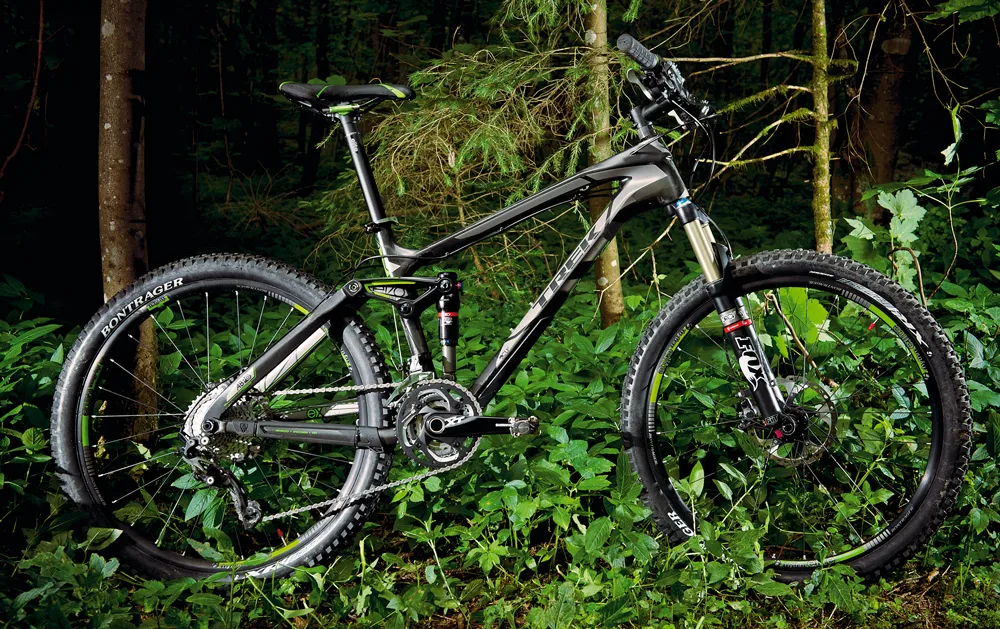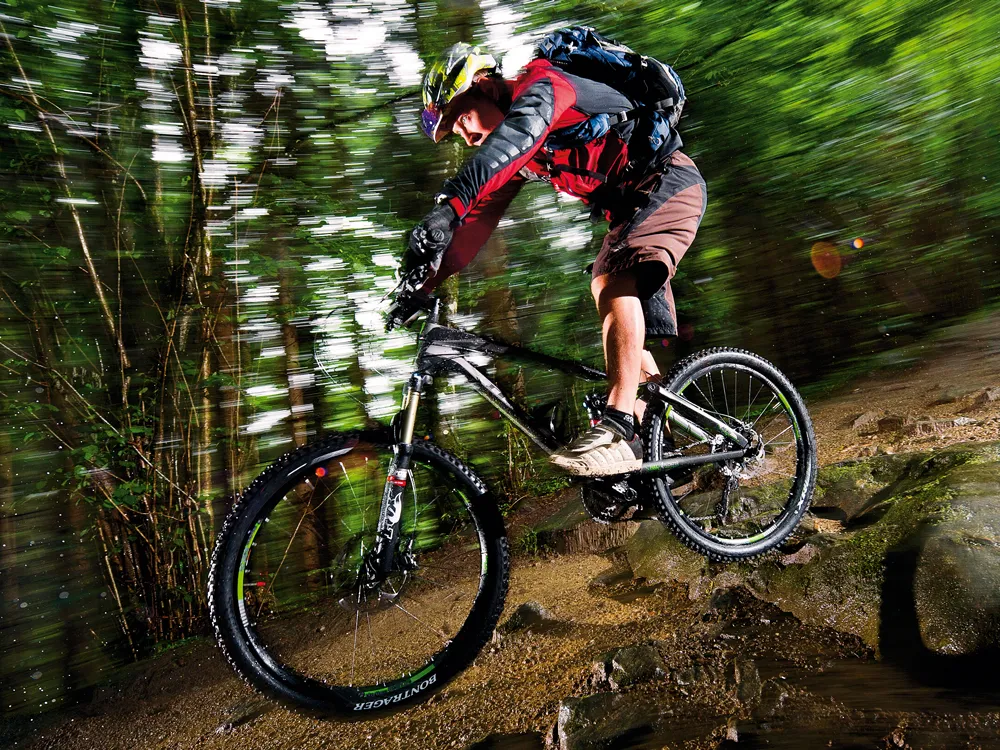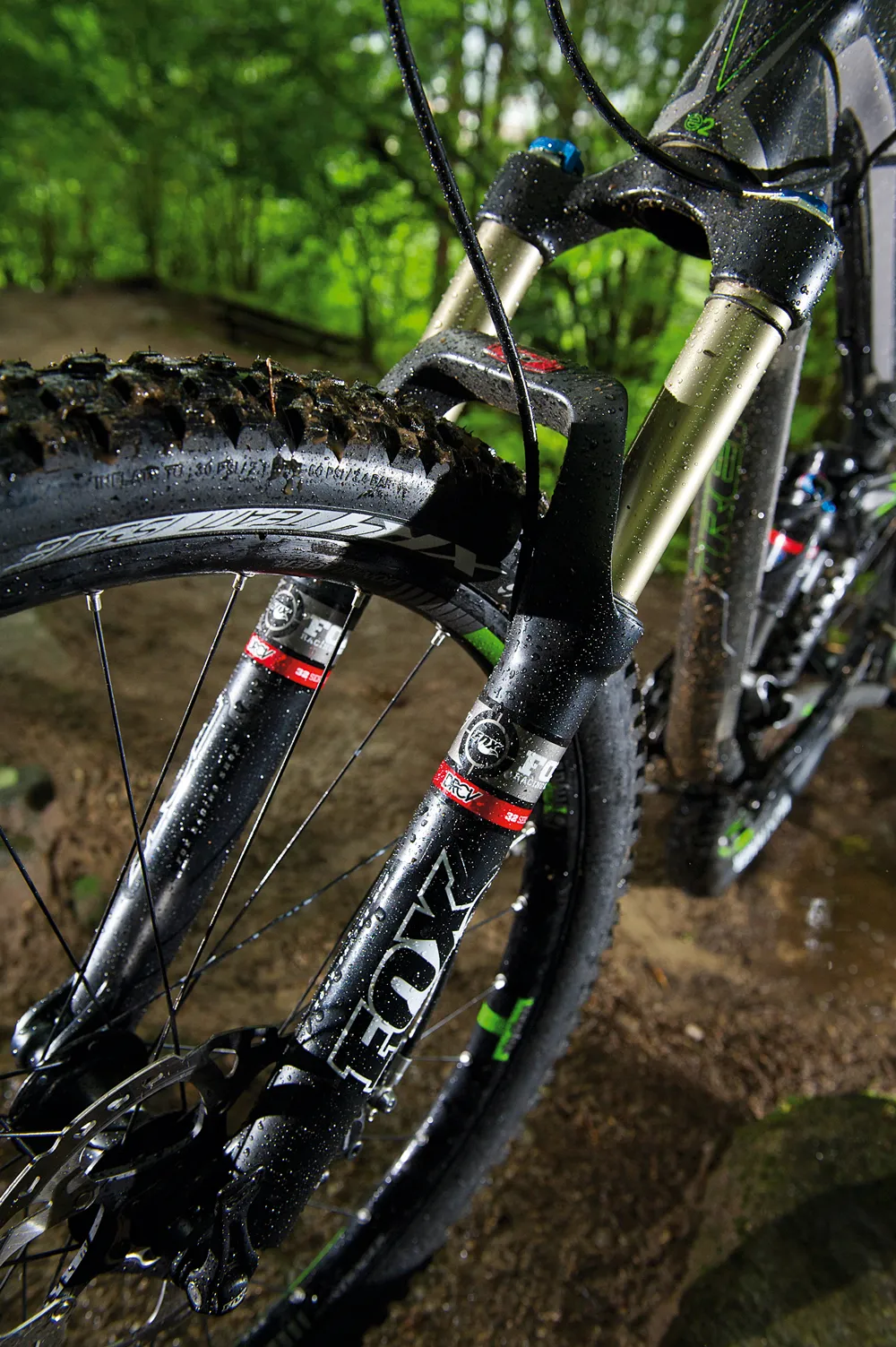The 120mm (5in) travel, Shimano XT-equipped carbon Fuel EX 9.8 is second from top in Trek’s Singletrack Trail Bike category, with only the SRAM XX 9.9 sitting above it in the pecking order. At first glance it’s still the same old reliable full floater that has scooped awards since the inception of Trek’s ABP (Active Braking Pivot) platform some four years ago, but Trek claims it’s a completely new bike for 2012. We got to test the EX 9.8 on the demanding trails of the Austrian Alps to find out.
The EX 9.8 swallowed up the bigger hits and lapped up the chaotic frenzies of roots you so often find on Alpine trails and it did so with a certain playfulness, helped noticeably by the DRCV (Dual Rate Control Valve) fork. On tight switchbacks and fast berms alike it held its line accurately, while the 3x10 gearing with its lower-than-2x10 first gear was appreciated on the longer uphill grunts. So does it deserve the ‘all new’ tag? Well, despite new geometry, tube and suspension performance it still rides like the EX we’ve grown to love; it’s just that it does it even better.
Ride & handling: Bob-free climbing prowess and a happy descender
With the DRCV (Dual Rate Control Valve) rear shock we always felt that the Fuel EX had a lot more to offer, almost like it was nudging the perceived boundaries of its 120mm travel pigeonhole. Riding the steep trails around Mayrhofen the EX’s geometry change was immediately noticeable, and we found ourselves happily diving down the same steep, stepped Alpine descents that we’d previously ridden on Trek's 150mm travel Remedy, albeit slightly slower on the Fuel EX.
The EX refused to get out of its depth. Playing with fork pressure we found the DRCV’s forte, it smoothly utilising its full travel while retaining poise through the mid stroke, without a ramp-up. Pump the bumps and get in the air, and the Fuel EX has the ability to bring you down again safely, it's suspension without quirks and easy to get to know.
The 680mm carbon bar felt comfortable, though an extra 20mm width wouldn’t be out of order if your riding veers towards pushing descents hard, and we’re surprised that the EX range has steered clear of dropper posts. Trek says that dropper posts are Remedy terrain, but with the capabilities of the new Fuel EX being wider we’d expect a lot of EX riders will be adding them, especially as the through-seat tube pivot prevented us dropping the long Bontrager post as much as we’d like on steep trails. Either way, luckily there’s a spare cable guide (freed up by the front mech internal cabling) under the top tube should you want to spec one.
With the bike retaining the same great, bob-free climbing prowess of previous incarnations, we found little use for full ProPedal lockout, but the new mid ProPedal setting gave a firm but traction-loving compromise to minimising squat. The back end felt tight and fast off the block helped by the stiff 142x12mm thru-axle as standard (Fuel EXs have ABP Convert drop-outs, allowing you to still run older 135x5 QR too), and further balancing the feel of the stiff QR15 fork up front. Brakes are powerful and well modulated though the new short XT levers are less easy to reach if you use middle finger braking.
Frame: Completely revised frameset
At the heart of Trek’s ‘all new’ claims sits a completely revised frameset, with new tube shapes dominating both the US-made OCLV (Optimum Compaction, Low Void) carbon and Far East Alpha Platinum aluminium frames of the eight-model line-up.
Despite aluminium chainstays, the 9.8’s frameset has still shed 100g from the 2011 version, in keeping with Trek’s main design targets of weight loss and performance gain. You have to look hard to see the changes in tube shape, but the main triangle is a smorgasbord of flowing carbon lines that effortlessly seem to add girth and stiffness where it’s needed. The head tube with integrated headset is still a stepped, E2 tapered monster hunk of carbon, giving the impression that it will take more abuse than is expected from it on a 120mm travel trail bike.
With new tubes comes the biggest change we’ll notice as riders, a 1-degree slacker head angle (now 68 degrees, unsagged), something that should lend the bike a more forgiving character, especially at speed, and hinting Trek is taking heed of developing riding styles.
A neat, unfussy graphite colour scheme is again heading more towards trail and is less racy, but lime green touches and colour-coded saddle (Bontrager’s Evoke 3 with titanium rails) and rim highlights elevate it from becoming understated. In keeping with the flowing looks, the top tube incorporates internal routing for the front mech cable.
Equipment: Proprietary fork delivers front end control
A new DRCV (Dual Rate Control Valve) Fox Float fork delivers to the front end the same control on big hits that we’ve come to like from the DRCV rear shock. Using a new secondary air chamber as an expansion chamber for mid-stroke compression, the proprietary fork is designed to boost control despite the faster riding style that slacker geometries allow.
According to Trek’s main suspension guru, Jose Gonzales, the new DRCV fork is “as important an impact as the introduction of the company’s ABP platform when it comes to the bike’s performance”. Meanwhile, a retuned rear shock comes with a new RP3 ProPedal, which offers a new ‘mid’ setting between off and on.




